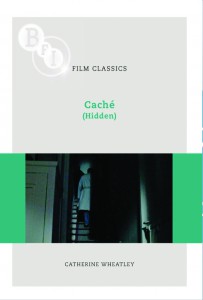By Catherine Wheatley. BFI Film Calssics series. (BFI Palgrave Macmillan, 2012). 96 pages. ISBN 978-1844573493 (paperback). Price: £10.99
 About the Author: Dr Michael Lawrence is a lecturer in Media and Film at the University of Sussex. Publications include an article on the 1958 Hindi-language film adaptation of Johanna Spyri's children's novel Heidi, published in 2012 in the Oxford University Press journal Adaptation; the history of transnational musical elements in Hindi film culture in a chapter on Indian cinema in The International Film Musical, eds. Corey K. Creekmur and Linda Y. Mokdad (Edinburgh University Press, 2012); an exploration of Austrian director Michael Haneke's presentation of animal life and death (and human actors and stars), published in On Michael Haneke, eds. John David Rhodes and Brian Price (Wayne State University Press, 2010); a study of the Taiwanese actor Lee Kang-sheng and 'non-professional' performance was published in Chinese Film Stars, eds. Yingjin Zhang and Mary Farquhar (Routledge, 2010).
E-mail: Michael.Lawrence@sussex.ac.uk
About the Author: Dr Michael Lawrence is a lecturer in Media and Film at the University of Sussex. Publications include an article on the 1958 Hindi-language film adaptation of Johanna Spyri's children's novel Heidi, published in 2012 in the Oxford University Press journal Adaptation; the history of transnational musical elements in Hindi film culture in a chapter on Indian cinema in The International Film Musical, eds. Corey K. Creekmur and Linda Y. Mokdad (Edinburgh University Press, 2012); an exploration of Austrian director Michael Haneke's presentation of animal life and death (and human actors and stars), published in On Michael Haneke, eds. John David Rhodes and Brian Price (Wayne State University Press, 2010); a study of the Taiwanese actor Lee Kang-sheng and 'non-professional' performance was published in Chinese Film Stars, eds. Yingjin Zhang and Mary Farquhar (Routledge, 2010).
E-mail: Michael.Lawrence@sussex.ac.uk
http://youtu.be/lS4VVUYsK44
Caché (or Hidden), the enigmatic thriller by the celebrated Austrian auteur Michael Haneke, has provoked intense confusion and even consternation among audiences and critics alike since its release in 2005, and so it is perhaps not surprising that it is the first of the director’s films to be included in the BFI’s Film Classics series. The film revolves around the Laurents, a bourgeois family living in Paris who inexplicably start receiving videotapes and drawings that eventually compels the father, Georges (Daniel Auteuil) to confront certain events from his childhood, specifically his relationship with Majid, the Algerian boy his parents temporarily adopted in the early 1970s. Haneke’s film has subsequently been widely understood and discussed as both a self-reflexive examination of media technologies and alienation and as an allegorical fable concerned with national memory and collective denial, and specifically post-colonial guilt and repression. As befits a film whose complexity and ambiguity demands and deserves repeated viewings, Catherine Wheatley’s incisive study loops back through the narrative several times, with each of its four chapters focusing our attention on distinct yet interrelated concerns, and it thereby reproduces Cache’s own strategy of re-presenting significant events from multiple perspectives.
... a rigorous and perceptive analysis which seeks to respect the film as an ultimately impermeable puzzle
The result is a rigorous and perceptive analysis which seeks to respect the film as an ultimately impermeable puzzle. The first chapter considers how the film reveals the director’s ‘awareness of, and facility with, the conventions of the thriller’ (p. 20), as well as its deployment of certain noirish elements, but the film’s (and Haneke’s) relation to an European art/auteur cinema tradition in which the genre film is appropriated only for its traditional satisfactions to be evacuated (beginning, perhaps, with Antonioni’s existential anti-thriller L’Avventura (1960)) deserved a little more discussion here. But the subsequent chapters examine, with confidence and clarity, the film’s representation of generational dynamics and ‘parental legacy’ (p. 52), its exploration of personal (and political) accountability, and its investigation of image technologies and the media.
 Each of the chapters includes detailed and imaginative analyses of particular scenes which attend not only to the significance of Haneke’s precise use of framing, editing and camera movement but also to the suggestiveness of his casting and the performances of his actors. Wheatley also explores the many resonant connections, both formal and thematic, that link Caché to the director’s other films (although the reuse of several of the actors from the earlier Code Unknown (2002) might have been acknowledged). Her discussion of the film’s presentation of the sullen twelve-year-old Pierrot Laurent (Lester Makedonsky) proceeds by reminding us of the many malevolent and menacing children that recur throughout the director’s oeuvre (his films, she argues, frequently imply that ‘we underestimate our children at our peril’ (p. 48)), but the question of Pierrot’s knowledge of his father’s past (tantalisingly raised by the film’s final scene, in which he is shown talking to Majid’s teenaged son) is one which Wheatley is wise to let remain unanswered. As she explains in the book’s introduction, the film is so compelling and challenging (or frustrating, even infuriating) precisely because it ‘leaves its viewers with a great many more questions than it does answers’ and ‘never offers a solution to its central enigma’ (p. 12). Wheatley wisely opts for an ‘aspectival approach’ (p. 86), one that offers a series of interlocking perspectives on the film rather than a ‘unilateral interpretation’ (p. 87), so as to avoid ‘the closing down of the multiplicity of meanings that Caché contains and the consigning of a fixed meaning to the film’ (p. 17).
Each of the chapters includes detailed and imaginative analyses of particular scenes which attend not only to the significance of Haneke’s precise use of framing, editing and camera movement but also to the suggestiveness of his casting and the performances of his actors. Wheatley also explores the many resonant connections, both formal and thematic, that link Caché to the director’s other films (although the reuse of several of the actors from the earlier Code Unknown (2002) might have been acknowledged). Her discussion of the film’s presentation of the sullen twelve-year-old Pierrot Laurent (Lester Makedonsky) proceeds by reminding us of the many malevolent and menacing children that recur throughout the director’s oeuvre (his films, she argues, frequently imply that ‘we underestimate our children at our peril’ (p. 48)), but the question of Pierrot’s knowledge of his father’s past (tantalisingly raised by the film’s final scene, in which he is shown talking to Majid’s teenaged son) is one which Wheatley is wise to let remain unanswered. As she explains in the book’s introduction, the film is so compelling and challenging (or frustrating, even infuriating) precisely because it ‘leaves its viewers with a great many more questions than it does answers’ and ‘never offers a solution to its central enigma’ (p. 12). Wheatley wisely opts for an ‘aspectival approach’ (p. 86), one that offers a series of interlocking perspectives on the film rather than a ‘unilateral interpretation’ (p. 87), so as to avoid ‘the closing down of the multiplicity of meanings that Caché contains and the consigning of a fixed meaning to the film’ (p. 17).
Michael Lawrence